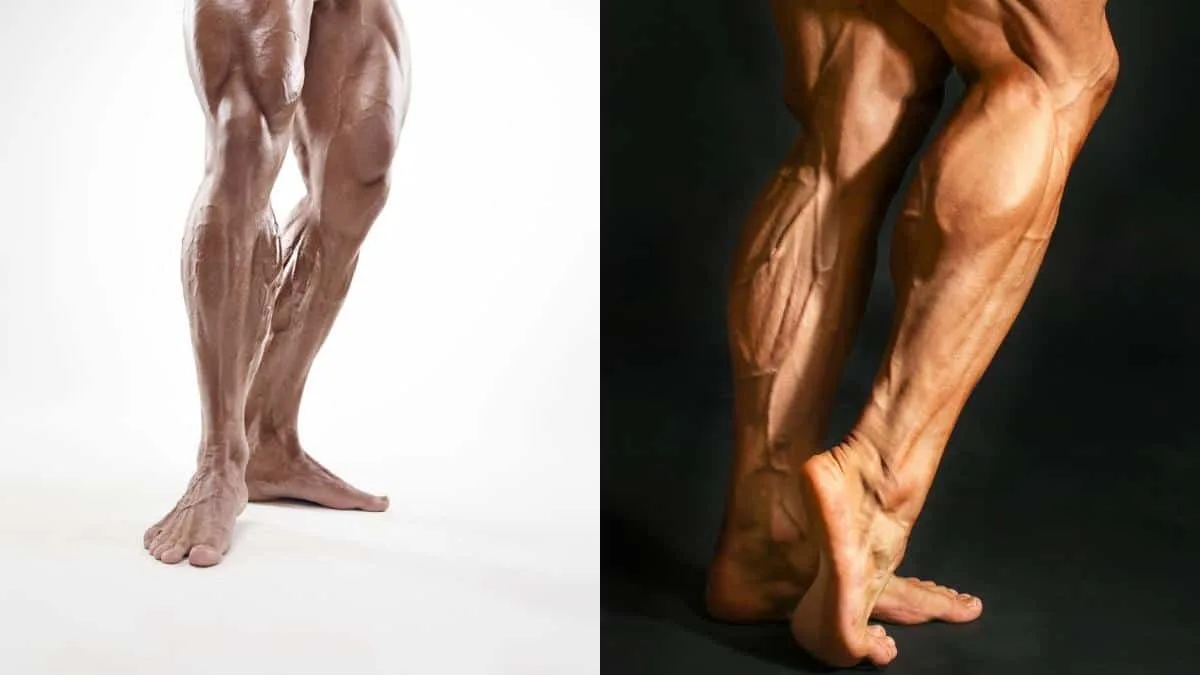Once you know the average calf size for a man, you’ll realize just how huge 24 inch calves are.
Some of the biggest and best bodybuilders don’t even have 23 inch calves despite training them for decades and bulking up to 300lbs.
Yet, there are a few bodybuilders and strength athletes that have managed to cross the 23 and 24 inch barriers. But before we examine these gifted individuals, let’s look at the requirements to build 23″ and 24″ calves.
Compare Your Calves:
How realistic is building 24 inch calves?
For 99% of people—including professional bodybuilders—building lean 24 inch calves isn’t possible because their genetics simply won’t allow their calves to grow to such a colossal size.
And even if you do have the genetics, you’ll need to train your calves hard and heavy for a decade or more to get them anywhere near the 23 inch mark.
Now, considering that most pro bodybuilders are absolutely shredded, it’s conceivable that a few of them could get 23 or 24 inch calves if they allowed themselves to gain some body fat.
Additionally, if you have good calf genetics and happen to be severely overweight, then you may also have 24 in calves. Although in this case, your calves wouldn’t, of course, be as muscular as those of a bodybuilder, even if they were bigger in terms of measurement.
Who has 23 inch calves and 24 inch calves?
Learn who has 23 in calves and 24 in calves by checking out these real-life case studies.
Eddie Hall
Strongman Eddie Hall doesn’t do much isolation work for his calves, and yet, they measure 23.5 inches, which is bigger than most men’s thighs.
Hall recommends focusing on heavy free-weight leg exercises if you want to build your calves but also notes that you can throw in a few isolation exercises as well.
I suppose when you can squat more weight than 99.99% of people, you don’t need to do many isolation exercises because your calves have to work so hard to stabilize your body during free weight squats.
Ben Pakulski
If you want to build your calves, listen to Ben Pakulski. His calf training tips have fixed countless pairs of puny lower legs, including my own, and he has the calf mass himself to back up his advice.
Pakulski’s calves measured 23 inches when he was competing and were easily the best of his era (and arguably of all time).
Pakulski is a stickler when it comes to execution. He notes how it’s crucial to master the proper calf-building form before you start loading weight onto your back or onto the machine.
As he’s fond of saying, your muscles respond to the tension that you put them under; your calves certainly can’t see how much weight is on the bar. So make sure to take Ben’s advice and focus on your form now so that you don’t have to reduce the resistance and fix your technique later.
Erik Fankhauser
2010 Mr. Olympia competitor Erik Fankhauser has some of the freakiest calves that the world has ever seen. At a colossal 24 inches, his calves have more mass than most people’s quads and far more detail, too.
Although Erik clearly trains his calves hard, there’s no denying that they’re genetically blessed to an extent.
His legs as a whole, for example, were always more much more developed than his upper body when he was competing (not that his upper body was small—his wheels were just huge).
Conclusion: What does it take to build 23 and 24 inch calves?
While I’m not aware of anyone with 25 inch calves, there are obviously a few gifted individuals with 23 and 24 inch calves.
Of course, getting your calves anywhere near the 23 inch mark requires exceptional genetics and the willingness to blast your lower legs on a consistent basis for a decade or more.
Some bodybuilders with a thinner frame, especially those with smaller ankles, simply don’t have the bone structure to hold the muscle mass that’s required to build 24 inch calves.
People like Eddie Hall and Ben Pakulski, on the other hand, both of whom have massive legs, clearly have a large lower body bone structure that’s capable of carrying a ton of calf mass.
References
- Zaino, C. (2019, January 18). Consistency: The Key To Progress In Your Fitness Program. Bodybuilding.Com. https://www.bodybuilding.com/fun/zaino16.htm

